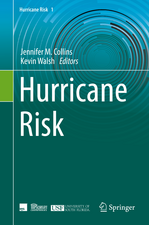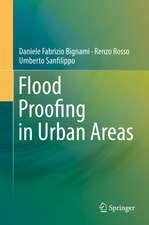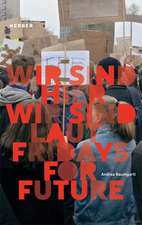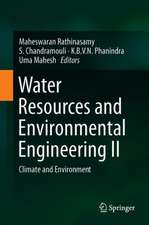Paris Climate Agreement: Beacon of Hope: Springer Climate
Autor Ross J. Salawitch, Timothy P. Canty, Austin P. Hope, Walter R. Tribett, Brian F. Bennetten Limba Engleză Paperback – 7 iul 2018
This book is open access under a CC BY 4.0 license.
This volume presents an Empirical Model of Global Climate developed by the authors and uses that model to show that global warming will likely remain below 2ºC, relative to preindustrial, throughout this century provided: a) both the unconditional and conditional Paris INDC commitments are followed; b) the emission reductions needed to achieve the Paris INDCs are carried forward to 2060 and beyond.
The first section of the book provides a short overview of Earth’s climate system, describing and contrasting climatic changes throughout the planet’s history and anthropogenic changes post-Industrial Revolution. The second section describes the climate model developed by the authors (Canty et al., Atmospheric Chemistry and Physics, 2013) and contrasts the model with climate models used in the Intergovernmental Panel on Climate Change (IPCC) 2013 Report. Chapter 3 examines both the unconditional (i.e., firm commitments) andconditional Paris INDCs (commitments contingent on financial flow and/or technology transfer) through the lens of their climate model and concludes that if all of the Paris INDCs are followed, then they are indeed a beacon of hope for Earth’s climate. The fourth part of the book offers a perspective of energy needs and subsequent emissions reductions required to meet the Paris temperature goals, illuminating challenges faced both in the developing world and the developed world. Throughout the book, easy-to-understand charts and graphics illustrate concepts. The scientific basis of Chapters 2 and 3 was first presented in a keynote session of the 96th Annual Meeting of the American Meteorological Society in January, 2016.
This volume presents an Empirical Model of Global Climate developed by the authors and uses that model to show that global warming will likely remain below 2ºC, relative to preindustrial, throughout this century provided: a) both the unconditional and conditional Paris INDC commitments are followed; b) the emission reductions needed to achieve the Paris INDCs are carried forward to 2060 and beyond.
The first section of the book provides a short overview of Earth’s climate system, describing and contrasting climatic changes throughout the planet’s history and anthropogenic changes post-Industrial Revolution. The second section describes the climate model developed by the authors (Canty et al., Atmospheric Chemistry and Physics, 2013) and contrasts the model with climate models used in the Intergovernmental Panel on Climate Change (IPCC) 2013 Report. Chapter 3 examines both the unconditional (i.e., firm commitments) andconditional Paris INDCs (commitments contingent on financial flow and/or technology transfer) through the lens of their climate model and concludes that if all of the Paris INDCs are followed, then they are indeed a beacon of hope for Earth’s climate. The fourth part of the book offers a perspective of energy needs and subsequent emissions reductions required to meet the Paris temperature goals, illuminating challenges faced both in the developing world and the developed world. Throughout the book, easy-to-understand charts and graphics illustrate concepts. The scientific basis of Chapters 2 and 3 was first presented in a keynote session of the 96th Annual Meeting of the American Meteorological Society in January, 2016.
| Toate formatele și edițiile | Preț | Express |
|---|---|---|
| Paperback (1) | 416.16 lei 43-57 zile | |
| Springer International Publishing – 7 iul 2018 | 416.16 lei 43-57 zile | |
| Hardback (1) | 423.47 lei 43-57 zile | |
| Springer International Publishing – 12 ian 2017 | 423.47 lei 43-57 zile |
Din seria Springer Climate
- 18%
 Preț: 1014.45 lei
Preț: 1014.45 lei - 15%
 Preț: 644.95 lei
Preț: 644.95 lei - 20%
 Preț: 753.10 lei
Preț: 753.10 lei - 18%
 Preț: 730.79 lei
Preț: 730.79 lei - 20%
 Preț: 505.38 lei
Preț: 505.38 lei - 17%
 Preț: 362.53 lei
Preț: 362.53 lei - 15%
 Preț: 646.62 lei
Preț: 646.62 lei - 18%
 Preț: 910.26 lei
Preț: 910.26 lei - 18%
 Preț: 1009.70 lei
Preț: 1009.70 lei - 18%
 Preț: 781.94 lei
Preț: 781.94 lei - 18%
 Preț: 1128.57 lei
Preț: 1128.57 lei - 18%
 Preț: 960.13 lei
Preț: 960.13 lei - 20%
 Preț: 513.20 lei
Preț: 513.20 lei - 18%
 Preț: 894.79 lei
Preț: 894.79 lei - 15%
 Preț: 596.87 lei
Preț: 596.87 lei - 15%
 Preț: 645.28 lei
Preț: 645.28 lei - 18%
 Preț: 893.84 lei
Preț: 893.84 lei - 18%
 Preț: 1113.39 lei
Preț: 1113.39 lei -
 Preț: 352.80 lei
Preț: 352.80 lei - 15%
 Preț: 638.76 lei
Preț: 638.76 lei - 18%
 Preț: 1001.19 lei
Preț: 1001.19 lei - 15%
 Preț: 639.90 lei
Preț: 639.90 lei - 18%
 Preț: 953.52 lei
Preț: 953.52 lei - 15%
 Preț: 642.18 lei
Preț: 642.18 lei - 15%
 Preț: 643.34 lei
Preț: 643.34 lei - 15%
 Preț: 656.25 lei
Preț: 656.25 lei - 15%
 Preț: 644.95 lei
Preț: 644.95 lei - 15%
 Preț: 690.11 lei
Preț: 690.11 lei - 15%
 Preț: 465.15 lei
Preț: 465.15 lei -
 Preț: 357.43 lei
Preț: 357.43 lei - 18%
 Preț: 1121.13 lei
Preț: 1121.13 lei - 18%
 Preț: 1114.34 lei
Preț: 1114.34 lei - 15%
 Preț: 696.82 lei
Preț: 696.82 lei - 18%
 Preț: 958.38 lei
Preț: 958.38 lei - 15%
 Preț: 697.15 lei
Preț: 697.15 lei
Preț: 416.16 lei
Nou
Puncte Express: 624
Preț estimativ în valută:
79.63€ • 83.35$ • 66.28£
79.63€ • 83.35$ • 66.28£
Carte tipărită la comandă
Livrare economică 31 martie-14 aprilie
Preluare comenzi: 021 569.72.76
Specificații
ISBN-13: 9783319836232
ISBN-10: 3319836234
Ilustrații: XVII, 186 p. 58 illus., 54 illus. in color.
Dimensiuni: 155 x 235 mm
Greutate: 0.3 kg
Ediția:Softcover reprint of the original 1st ed. 2017
Editura: Springer International Publishing
Colecția Springer
Seria Springer Climate
Locul publicării:Cham, Switzerland
ISBN-10: 3319836234
Ilustrații: XVII, 186 p. 58 illus., 54 illus. in color.
Dimensiuni: 155 x 235 mm
Greutate: 0.3 kg
Ediția:Softcover reprint of the original 1st ed. 2017
Editura: Springer International Publishing
Colecția Springer
Seria Springer Climate
Locul publicării:Cham, Switzerland
Cuprins
Chapter 1. Earth's Climate System.- Chapter 2. Forecasting Global Warming.- Chapter 3. Paris INDCs.- Chapter 4. Implementation.
Notă biografică
Ross Salawitch serves as Professor in the Departments of Atmospheric and Oceanic Science, Chemistry and Biochemistry, as well as the Earth System Science Interdisciplinary Center at the University of Maryland. Before coming to Maryland in 2007, he served as a Research Scientist at NASA's Jet Propulsion Laboratory. Dr. Salawitch has been named as a Highly Cited Researcher in Geosciences by Thompson Scientific, which recognizes the 250 most cited researchers in the field of geosciences during the past twenty years.
Tim Canty is an Assistant Research Professor in the Department of Atmospheric and Oceanic Science at the University of Maryland. He is currently the director of the undergraduate and professional masters programs for his department. Before coming to Maryland, Dr. Canty was a postdoctoral scholar at NASA's Jet Propulsion Laboratory and a lecturer in the Department of Atmospheric and Oceanic Sciences at UCLA.
Austin Hopeis a PhD candidate in the Department of Atmospheric and Oceanic Science at the University of Maryland. Before coming to the University of Maryland, Austin earned his bachelor's degree at Washington University in St. Louis with College Honors in Arts & Sciences. He participated in the Honorary Scholars Program while majoring in Mathematics and minoring in Earth & Planetary Sciences as well as Physics.
Walter Tribett serves as Faculty Assistant in the Department of Atmospheric and Oceanic Science at the University of Maryland. Prior to this position, he graduated with a Bachelors of Science degree from the University of Maryland in 2014, earning the Henry E. Fleming Scholarship Award. In 2015 he attended the 21st Conference of the Parties meeting in Paris, as an observer for the University of Maryland delegation.
Brian Bennett serves as Faculty Assistant in the Department of Atmospheric and Oceanic Science at the University of Maryland. Brian is a beginning career atmospheric scientist and a recent graduate of the department’s Master of Professional Studies, class of 2015. Prior to his studies at Maryland, he had earned a Bachelor of Science in Biological Anthropology at the George Washington University, in 2006, where he was a recipient of their Presidential Academic Scholarship.
Tim Canty is an Assistant Research Professor in the Department of Atmospheric and Oceanic Science at the University of Maryland. He is currently the director of the undergraduate and professional masters programs for his department. Before coming to Maryland, Dr. Canty was a postdoctoral scholar at NASA's Jet Propulsion Laboratory and a lecturer in the Department of Atmospheric and Oceanic Sciences at UCLA.
Austin Hopeis a PhD candidate in the Department of Atmospheric and Oceanic Science at the University of Maryland. Before coming to the University of Maryland, Austin earned his bachelor's degree at Washington University in St. Louis with College Honors in Arts & Sciences. He participated in the Honorary Scholars Program while majoring in Mathematics and minoring in Earth & Planetary Sciences as well as Physics.
Walter Tribett serves as Faculty Assistant in the Department of Atmospheric and Oceanic Science at the University of Maryland. Prior to this position, he graduated with a Bachelors of Science degree from the University of Maryland in 2014, earning the Henry E. Fleming Scholarship Award. In 2015 he attended the 21st Conference of the Parties meeting in Paris, as an observer for the University of Maryland delegation.
Brian Bennett serves as Faculty Assistant in the Department of Atmospheric and Oceanic Science at the University of Maryland. Brian is a beginning career atmospheric scientist and a recent graduate of the department’s Master of Professional Studies, class of 2015. Prior to his studies at Maryland, he had earned a Bachelor of Science in Biological Anthropology at the George Washington University, in 2006, where he was a recipient of their Presidential Academic Scholarship.
Textul de pe ultima copertă
This book is open access under a CC BY 4.0 license.
This volume presents an Empirical Model of Global Climate developed by the authors and uses that model to show that global warming will likely remain below 2ºC, relative to preindustrial, throughout this century provided: a) both the unconditional and conditional Paris INDC commitments are followed; b) the emission reductions needed to achieve the Paris INDCs are carried forward to 2060 and beyond.
The first section of the book provides a short overview of Earth’s climate system, describing and contrasting climatic changes throughout the planet’s history and anthropogenic changes post-Industrial Revolution. The second section describes the climate model developed by the authors (Canty et al., Atmospheric Chemistry and Physics, 2013) and contrasts the model with climate models used in the Intergovernmental Panel on Climate Change (IPCC) 2013 Report. Chapter 3 examines both the unconditional (i.e., firm commitments) and conditional Paris INDCs (commitments contingent on financial flow and/or technology transfer) through the lens of their climate model and concludes that if all of the Paris INDCs are followed, then they are indeed a beacon of hope for Earth’s climate. The fourth part of the book offers a perspective of energy needs and subsequent emissions reductions required to meet the Paris temperature goals, illuminating challenges faced both in the developing world and the developed world.
Throughout the book, easy-to-understand charts and graphics illustrate concepts. The scientific basis of Chapters 2 and 3 was first presented in a keynote session of the 96th Annual Meeting of the American Meteorological Society in January, 2016.
This volume presents an Empirical Model of Global Climate developed by the authors and uses that model to show that global warming will likely remain below 2ºC, relative to preindustrial, throughout this century provided: a) both the unconditional and conditional Paris INDC commitments are followed; b) the emission reductions needed to achieve the Paris INDCs are carried forward to 2060 and beyond.
The first section of the book provides a short overview of Earth’s climate system, describing and contrasting climatic changes throughout the planet’s history and anthropogenic changes post-Industrial Revolution. The second section describes the climate model developed by the authors (Canty et al., Atmospheric Chemistry and Physics, 2013) and contrasts the model with climate models used in the Intergovernmental Panel on Climate Change (IPCC) 2013 Report. Chapter 3 examines both the unconditional (i.e., firm commitments) and conditional Paris INDCs (commitments contingent on financial flow and/or technology transfer) through the lens of their climate model and concludes that if all of the Paris INDCs are followed, then they are indeed a beacon of hope for Earth’s climate. The fourth part of the book offers a perspective of energy needs and subsequent emissions reductions required to meet the Paris temperature goals, illuminating challenges faced both in the developing world and the developed world.
Throughout the book, easy-to-understand charts and graphics illustrate concepts. The scientific basis of Chapters 2 and 3 was first presented in a keynote session of the 96th Annual Meeting of the American Meteorological Society in January, 2016.
Caracteristici
Presents the first comprehensive assessment of Paris INDCs tied to a climate model Transparently and convincingly argues that if conditional Paris INDC commitments are followed and improvements in carbon intensity needed to achieve the Paris INDCs are carried forward to 2060 and beyond, global warming will likely remain 2ºC below pre-industrial throughout this century Useful for researchers, accessible to policymakers, and appropriate for use in graduate and undergraduate courses Includes supplementary material: sn.pub/extras


























